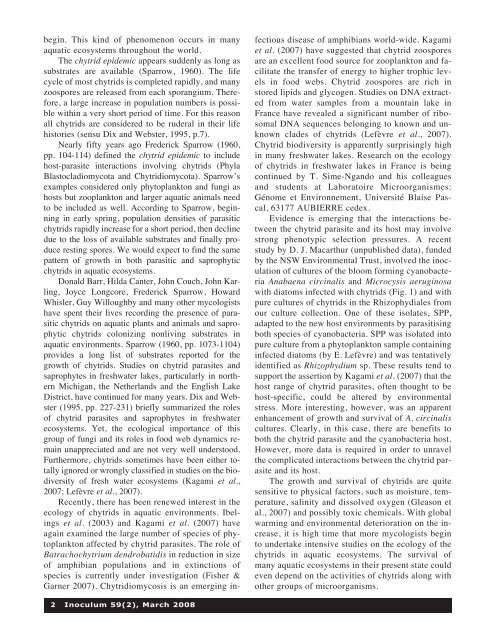March 2008 - Mycological Society of America
March 2008 - Mycological Society of America
March 2008 - Mycological Society of America
Create successful ePaper yourself
Turn your PDF publications into a flip-book with our unique Google optimized e-Paper software.
egin. This kind <strong>of</strong> phenomenon occurs in many<br />
aquatic ecosystems throughout the world.<br />
The chytrid epidemic appears suddenly as long as<br />
substrates are available (Sparrow, 1960). The life<br />
cycle <strong>of</strong> most chytrids is completed rapidly, and many<br />
zoospores are released from each sporangium. Therefore,<br />
a large increase in population numbers is possible<br />
within a very short period <strong>of</strong> time. For this reason<br />
all chytrids are considered to be ruderal in their life<br />
histories (sensu Dix and Webster, 1995, p.7).<br />
Nearly fifty years ago Frederick Sparrow (1960,<br />
pp. 104-114) defined the chytrid epidemic to include<br />
host-parasite interactions involving chytrids (Phyla<br />
Blastocladiomycota and Chytridiomycota). Sparrow’s<br />
examples considered only phytoplankton and fungi as<br />
hosts but zooplankton and larger aquatic animals need<br />
to be included as well. According to Sparrow, beginning<br />
in early spring, population densities <strong>of</strong> parasitic<br />
chytrids rapidly increase for a short period, then decline<br />
due to the loss <strong>of</strong> available substrates and finally produce<br />
resting spores. We would expect to find the same<br />
pattern <strong>of</strong> growth in both parasitic and saprophytic<br />
chytrids in aquatic ecosystems.<br />
Donald Barr, Hilda Canter, John Couch, John Karling,<br />
Joyce Longcore, Frederick Sparrow, Howard<br />
Whisler, Guy Willoughby and many other mycologists<br />
have spent their lives recording the presence <strong>of</strong> parasitic<br />
chytrids on aquatic plants and animals and saprophytic<br />
chytrids colonizing nonliving substrates in<br />
aquatic environments. Sparrow (1960, pp. 1073-1104)<br />
provides a long list <strong>of</strong> substrates reported for the<br />
growth <strong>of</strong> chytrids. Studies on chytrid parasites and<br />
saprophytes in freshwater lakes, particularly in northern<br />
Michigan, the Netherlands and the English Lake<br />
District, have continued for many years. Dix and Webster<br />
(1995, pp. 227-231) briefly summarized the roles<br />
<strong>of</strong> chytrid parasites and saprophytes in freshwater<br />
ecosystems. Yet, the ecological importance <strong>of</strong> this<br />
group <strong>of</strong> fungi and its roles in food web dynamics remain<br />
unappreciated and are not very well understood.<br />
Furthermore, chytrids sometimes have been either totally<br />
ignored or wrongly classified in studies on the biodiversity<br />
<strong>of</strong> fresh water ecosystems (Kagami et al.,<br />
2007; Lefèvre et al., 2007).<br />
Recently, there has been renewed interest in the<br />
ecology <strong>of</strong> chytrids in aquatic environments. Ibelings<br />
et al. (2003) and Kagami et al. (2007) have<br />
again examined the large number <strong>of</strong> species <strong>of</strong> phytoplankton<br />
affected by chytrid parasites. The role <strong>of</strong><br />
Batrachochytrium dendrobatidis in reduction in size<br />
<strong>of</strong> amphibian populations and in extinctions <strong>of</strong><br />
species is currently under investigation (Fisher &<br />
Garner 2007). Chytridiomycosis is an emerging in-<br />
2 Inoculum 59(2), <strong>March</strong> <strong>2008</strong><br />
fectious disease <strong>of</strong> amphibians world-wide. Kagami<br />
et al. (2007) have suggested that chytrid zoospores<br />
are an excellent food source for zooplankton and facilitate<br />
the transfer <strong>of</strong> energy to higher trophic levels<br />
in food webs. Chytrid zoospores are rich in<br />
stored lipids and glycogen. Studies on DNA extracted<br />
from water samples from a mountain lake in<br />
France have revealed a significant number <strong>of</strong> ribosomal<br />
DNA sequences belonging to known and unknown<br />
clades <strong>of</strong> chytrids (Lefèvre et al., 2007).<br />
Chytrid biodiversity is apparently surprisingly high<br />
in many freshwater lakes. Research on the ecology<br />
<strong>of</strong> chytrids in freshwater lakes in France is being<br />
continued by T. Sime-Ngando and his colleagues<br />
and students at Laboratoire Microorganismes:<br />
Génome et Environnement, Université Blaise Pascal,<br />
63177 AUBIERRE cedex.<br />
Evidence is emerging that the interactions between<br />
the chytrid parasite and its host may involve<br />
strong phenotypic selection pressures. A recent<br />
study by D. J. Macarthur (unpublished data), funded<br />
by the NSW Environmental Trust, involved the inoculation<br />
<strong>of</strong> cultures <strong>of</strong> the bloom forming cyanobacteria<br />
Anabaena circinalis and Microcysis aeruginosa<br />
with diatoms infected with chytrids (Fig. 1) and with<br />
pure cultures <strong>of</strong> chytrids in the Rhizophydiales from<br />
our culture collection. One <strong>of</strong> these isolates, SPP,<br />
adapted to the new host environments by parasitising<br />
both species <strong>of</strong> cyanobacteria. SPP was isolated into<br />
pure culture from a phytoplankton sample containing<br />
infected diatoms (by E. Lefèvre) and was tentatively<br />
identified as Rhizophydium sp. These results tend to<br />
support the assertion by Kagami et al. (2007) that the<br />
host range <strong>of</strong> chytrid parasites, <strong>of</strong>ten thought to be<br />
host-specific, could be altered by environmental<br />
stress. More interesting, however, was an apparent<br />
enhancement <strong>of</strong> growth and survival <strong>of</strong> A. circinalis<br />
cultures. Clearly, in this case, there are benefits to<br />
both the chytrid parasite and the cyanobacteria host.<br />
However, more data is required in order to unravel<br />
the complicated interactions between the chytrid parasite<br />
and its host.<br />
The growth and survival <strong>of</strong> chytrids are quite<br />
sensitive to physical factors, such as moisture, temperature,<br />
salinity and dissolved oxygen (Gleason et<br />
al., 2007) and possibly toxic chemicals. With global<br />
warming and environmental deterioration on the increase,<br />
it is high time that more mycologists begin<br />
to undertake intensive studies on the ecology <strong>of</strong> the<br />
chytrids in aquatic ecosystems. The survival <strong>of</strong><br />
many aquatic ecosystems in their present state could<br />
even depend on the activities <strong>of</strong> chytrids along with<br />
other groups <strong>of</strong> microorganisms.
















